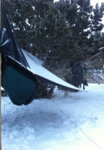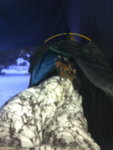So obviously the ideal campsite is generally the flattest spot you can find. I always try and look for the most ideal spot I can but hunting in the mountains of coastal BC I often end up on a bit of a slope and find myself sliding around quite a bit throughout the night due to a slick sleeping bag overtop a slick sleeping pad overtop a slick piece of tyvek. Never had issues with water coming in the floorless but I have actually woke up with my feet sticking out the bottom of the tent during a rainstorm, luckily my bag has a pretty water resistant shell. I've seen quite a few photos on here of tipis that look to be pitched in pretty steep terrain so thought I would ask if anyone has any tips for not sliding around on your pad/tyvek when camped on a slope. One trick I've heard is a few dots of seam sealer on the sleeping pad/tyvek so will have to try that out and see if it helps at all, any other hot tips out there?
Navigation
Install the app
How to install the app on iOS
Follow along with the video below to see how to install our site as a web app on your home screen.
Note: This feature may not be available in some browsers.
More options
Style variation
You are using an out of date browser. It may not display this or other websites correctly.
You should upgrade or use an alternative browser.
You should upgrade or use an alternative browser.
Camping in steep country
- Thread starter BackcountryBloodline
- Start date
Poser
WKR
This is a very tough aspect of hunting the San Juan range in SW CO. Hammock setups work great for this but it’s just not for me. With much experimentation, I have found that a bivy sack works well because it contains your gear, but to further improve the situation, you need to stake your bivy sack in place with 1-4 stakes. Sometimes I’ll build a “wall” with rocks and gear to help keep me on the tiny flat spot or to help bridge a slope.
Get some tent seam sealer and a 2 inch foam brush. "Paint" some lines vertically across the Tyvek. Then paint some horizontal lines on the bottom of your sleeping pad. This will add some friction between those two surfaces and will help with that part of the sliding.
This is a very tough aspect of hunting the San Juan range in SW CO. Hammock setups work great for this but it’s just not for me. With much experimentation, I have found that a bivy sack works well because it contains your gear, but to further improve the situation, you need to stake your bivy sack in place with 1-4 stakes. Sometimes I’ll build a “wall” with rocks and gear to help keep me on the tiny flat spot or to help bridge a slope.
A hammock setup would actually be perfect for the area I do most of my hunting but I usually have my son with me so I've generally been pitching a tarp for the two of us, have also heard that condensation can be a real issue and a stove to dry out at the end of the day is a real game changer up here. A staked out bivy inside the tipi might be something to think about for sure though, thanks!
Get some tent seam sealer and a 2 inch foam brush. "Paint" some lines vertically across the Tyvek. Then paint some horizontal lines on the bottom of your sleeping pad. This will add some friction between those two surfaces and will help with that part of the sliding.
This sounds much more effective than the "few dots" I had originally heard about, good call!
I use a bug bivy now rather than a piece of tyvek to put my pad and bag in and it helps keep me from sliding as much, bonus that if it is buggy I have that covered. I'm sure some seam sealer on each sides of my pad would help further.
I use a bug bivy now rather than a piece of tyvek to put my pad and bag in and it helps keep me from sliding as much, bonus that if it is buggy I have that covered. I'm sure some seam sealer on each sides of my pad would help further.
I think a pair of bug bivys may very well be in our future, my son just recently asked for a bivy and I've been tossing the idea around myself for a while now although I generally just wear a headnet when bugs are bad...don't like the idea of a tick getting into my sleeping bag though. I noticed slumberjack has a very reasonably priced bug bivy, anyone have any experience with those?
PS @pods8 I've been seeing your pack work on here and getting inspired, was actually just looking at used sewing machines today and brainstorming on a DIY lid for my bounty 2.0
Last edited:
Where's Bruce?
WKR
- Joined
- Sep 22, 2013
- Messages
- 6,387
Nice setup. How's the condensation in there and do you know the weight off the top of your head?
MuleyFever
WKR
The seam sealer sounds awesome. Do you find you need to reapply frequently? Or does it last a decent amount of time?
You just add some mineral spirits to silicone to thin it a bit and paint it on. It will stay on for years. Also apply to your pad. I have also just used straight silicone. Works fine.
Where's Bruce?
WKR
- Joined
- Sep 22, 2013
- Messages
- 6,387
Nice setup. How's the condensation in there and do you know the weight off the top of your head?
No condensation issues. Part of that ability is getting thru the initial learning curve which is where most folks fail with hammocks. I have a very large Mega Ogee tarp with storm doors which allows me to run it higher than others. I get claustrophobic and need a high ceiling in my shelter. This eliminates condensation. I also like to see out so during this snowy trek...one side of my tarp was anchored at a sharp angle (almost straight down) to fend off a strong north wind while the quiet side is pitched up so I have a view.
Windy side-
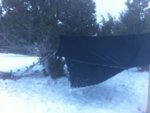
Quiet side-
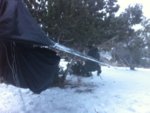
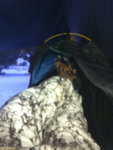
You can make a lot of such adjustments with the right tarp. A hammock like mine (top-of-the-line all season hammock with bug netting and weather shield) will vary in weight based on temps...6 to 10lbs and will pack down to the size of two large coffee cans. it gets heavier when you abandon the top quilt in favor of a heavy duty synthetic sleeping bag (which I sometimes do on extended trips where weather is gonna be wet). That alone can add 3lbs but hey, it's your ass and you don't wanna freeze it off. A shelter is your lifeline.
The nice thing about a hammock is you don't need flat ground without rocks and roots...you can hang from a 60 degree slope plus in nasty weather there's no mud getting on your shelter which can go up very fast. I quickly string my tarp then comfortably hang my hammock outta the wind and weather. If camping without a stove in the cold, it is easier to stay warm in a hammock than a tent using only your body heat. It's my GO TO shelter for bivy treks. I used to take 6 week motorcycle tours...ride in one direction for a while, come to a fork in the road and flip a coin...see where it takes me. Got myself in all kinds of good and bad situations that way but was always able to find a place to pitch my hammock...even in Kansas. Hung between two big pieces of farming equipment. <g>
But hammock camping takes commitment. First ya gotta find the type of hammock that suits you and how you sleep, then you hafta get Whoopie Slings and learn to adjust the angle of the dangle for maximum comfort and field test different insulation options (top quilt or TQ and under quilt or UQ vs a sleeping bag. It takes probably two weeks of regular use to figure it out and get quick at set-up and tear down. I practiced in my backyard during winter. My family looked at me funny when I got excited about rain and hail in the weather forecast and set up a hammock outside to test a new UQ & TQ.
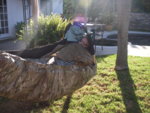
Yup...the hammock's under there.
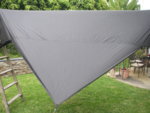
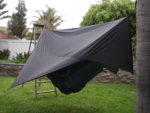
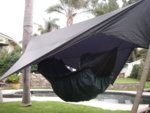
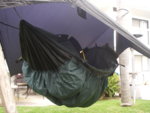
I'll be honest...there were nights I crept back into the house and crawled into my bed cuz I couldn't take the cold. But better to learn your clothing and insulation choices were wrong this way than when you're in the middle of nowhere.
I test all shelters and sleep systems in the backyard first.
Last edited:
LitenFast
WKR
I’ve also tried to improve how level my sleeping pad is with my butt pad and mostly empty pack by putting them under my pad on the low side.
Sent from my iPhone using Tapatalk
Sent from my iPhone using Tapatalk
You just add some mineral spirits to silicone to thin it a bit and paint it on. It will stay on for years. Also apply to your pad. I have also just used straight silicone. Works fine.
This is what I do. Cheap and effective.
Lawnboi
WKR
Same with the mineral spirits and silicone
I also run a lightweight bivy. It keeps it all together.
I also run a lightweight bivy. It keeps it all together.
Similar threads
- Replies
- 18
- Views
- 576
Featured Video
Latest Articles
- TT#64 Josh Boyd Elk Hunting Strategies for Every Season
- Aaron Davidson of Gunwerks
- TT#63 Dirk Durham’s Art of Elk Calling
- BIG Buck Stories with the Dirty Giants Podcast
- TT#62 Brian Barney Hunting Bulls without Calling
- Hoyt Alpha AX-2 SD Review
- Kuiu Kenai vs Outdoor Vitals Vario Hooded Jacket Review
- Hoyt RX-9 Ultra Review
- Hunting Vampire Bucks & Building an Optics Kit
- Darton Sequel ST2 35 Review

